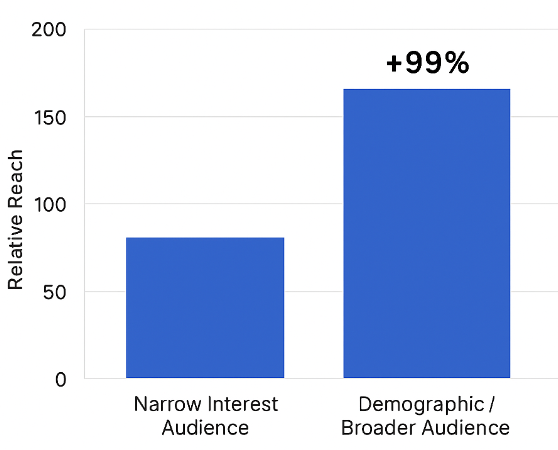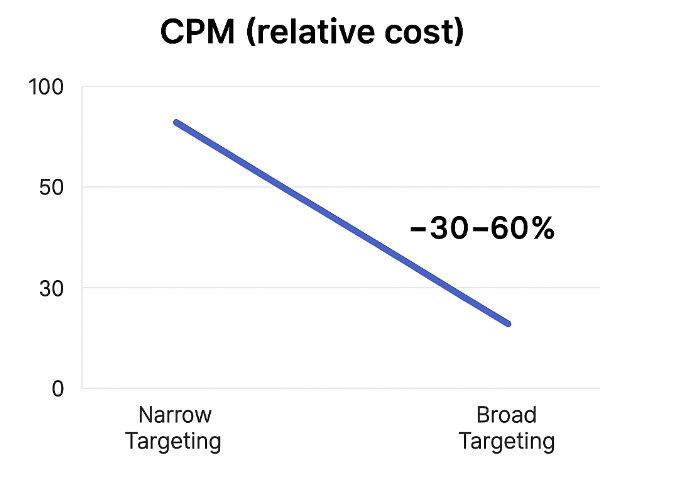Digital advertising platforms have evolved into predictive engines that identify high-value users with minimal manual input. Broad targeting works because algorithms now evaluate thousands of signals in real time—far beyond what manual audience selection can do.
Recent performance data shows that advertisers using broad targeting often see lower CPMs and more stable delivery. In Meta’s ecosystem, campaigns using broad audiences have been observed to reduce CPA by up to 23% compared to narrow interest stacks, due to expanded reach and better optimization flexibility.
When Broad Targeting Outperforms Narrow

Broader audiences can nearly double reach compared to narrow interest audiences (same budget)
Below are the clearest scenarios where broad beats narrow.
1. When You Have a Strong Conversion Signal
If your pixel tracks enough high-quality conversion events, broad targeting allows the algorithm to find patterns faster. Accounts with over 50 weekly conversion events typically see more efficient learning and wider optimization windows.
Key stat: Advertisers meeting this event threshold often achieve 15–30% lower CPA versus narrow targeting methods.
2. When Your Budget Is More Than $100 per Ad Set per Day
Broader audiences prevent early fatigue and reduce frequency. Narrow interest stacks hit saturation quickly—especially when budgets grow.
A broad audience unlocks larger delivery pools, allowing platforms to maintain healthy CPMs and stable reach.

Broad targeting can reduce CPM by 30–60% compared with narrow targeting
Key stat: CPM increases of 18–25% usually occur when narrow audiences hit limited inventory, forcing algorithms to bid higher.
3. When Creative Is Strong and Conversion-Oriented
Broad targeting works best with creatives that clearly communicate value, demonstrate use cases, or highlight social proof. Strong creatives guide algorithms because high click-to-conversion consistency signals user intent.
Key stat: Tests show that creative-led broad targeting can increase CVR by up to 32% compared to narrow interest targeting with the same creatives.
When Narrow Still Performs Better
Although broad targeting is powerful, narrow audience setups win in certain circumstances.
1. When You Sell to a Niche Market
Products with very specific buyer profiles—such as technical equipment or specialized professional tools—perform better with defined audience layers.
2. When You Have Limited Data
New ad accounts or early-stage funnels with fewer than 15 conversions per week lack the algorithmic maturity to benefit fully from broad targeting.
3. When Messaging Is Highly Persona-Specific
If your offer targets distinct segments with different pain points, separate narrow audiences allow tailored creative and landing pages.
How to Transition From Narrow to Broad
Follow these steps to transition without disrupting performance:
-
Start with a Lookalike or broad-interest hybrid, then expand to fully broad once stable results appear.
-
Use conversion-focused optimization events, such as "Purchase" or "Lead" rather than "View Content".
-
Test at least 2–3 strong creatives to provide algorithms with variation.
-
Monitor frequency and CPM weekly—stable or decreasing levels indicate successful broad delivery.
Best Practices for Broad Targeting Success
-
Use high-quality data sources: pixel events, product catalog signals, and retargeting pools.
-
Keep ad sets simple: fewer interests, no excessive exclusions.
-
Rely on performance-based bidding strategies.
-
Consolidate budgets whenever possible to avoid fragmentation.
Conclusion
Broad targeting isn’t just a scaling tactic—it’s becoming the default approach for high-performing campaigns. When algorithms have enough conversion data, creative variety, and adequate budget, broad consistently beats narrow setups by lowering costs, increasing reach, and improving CPA stability.

